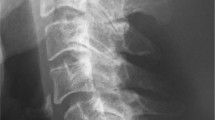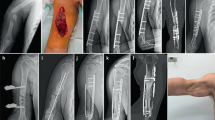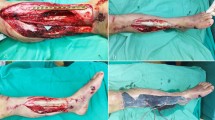Abstract
Study design:
Case report.
Objective:
To report a rare complication following halo placement for cervical fracture.
Setting:
United States University Teaching Hospital.
Case report:
A 39-year-old woman who sustained a spinal cord injury from a C6–7 fracture underwent halo placement. She subsequently developed an infection adjacent to the right posterior pin, which then became infected with Diptera larvae (maggots), necessitating removal of the pin and debridement of the wound site.
Conclusion:
Halo orthosis continues to be an effective means of immobilizing the cervical spine. Incidence of complications ranges from 6.4 to 36.0% of cases. Commonly reported complications include pin-site infection, pin penetration, pin loosening, pressure sores, nerve injury, bleeding, and head ring migration. Pin-site myiasis is rare, with no known reports found in the literature. Poor pin-site care by the patient and her failure to keep follow-up appointments after development of the initial infection likely contributed to the development of this complication.
Similar content being viewed by others
Introduction
Initially described by Perry and Nickel in 1959,1 the halo orthosis continues to be an effective means of stabilizing the cervical spine. Reported incidence of complications associated with halo usage vary from 6.4 to 36.0% of cases.2, 3, 4 Most complications are associated with pin-site infection, pin penetration through the inner table of the skull, pin loosening, pressure sores, nerve injury, bleeding, and head ring migration.3, 4, 5 Uncommon infectious complications include the development of intraparenchymal, epidural, or subdural abscesses related to pin penetration.5, 6, 7, 8, 9, 10 In contrast, pin-site infections are relatively frequent with reported incidence ranging between 5.3 and 20.0% of cases.2, 3, 11, 12, 13 Typically bacterial in origin, most pin-site infections are effectively treated with pin removal, wound care, and/or antibiotics.
We present an unusual case of a pin-site myiasis. Myiasis describes the condition in which a human or other mammal is infected by Diptera larvae (maggots).14 To our knowledge, this rare complication of halo orthosis has not been previously reported.
Case report
A 39-year-old woman with a past medical history significant for ongoing drug abuse presented as a transfer from an outside facility for management of a gunshot wound to her neck. Initial evaluation at an outside facility was concerned for a spinal cord injury, prompting institution of high-dose steroids prior to transfer. Upon arrival at our hospital, she was awake and alert but complained of neck pain and weakness of her right side. On neurologic examination, the patient was noted to have hemiparesis of the right side and decreased left-sided sensation to pin-prick, consistent with Brown–Sequard syndrome. Evaluation by computed tomography demonstrated an extensive comminuted fracture involving the right C6–7 facet extending to the lamina of C7. Subsequent magnetic resonance imaging demonstrated increased signal on T2-weighted sequences at the C5–6 level, consistent with spinal cord injury. No significant canal compromise was appreciated, however.
Based on the location and extent of the fracture, a halo orthosis was felt to be a reasonable treatment option. An appropriately sized halo ring was selected. Anteriorly, a pin was placed approximately 1 cm above the lateral aspect of each eyebrow, while posteriorly, a pin was inserted above either mastoid region. Each pin was then tightened to 8-inch-pounds. The pins were retightened approximately 24 h later. Routine pin care involving cleaning of the pin sites with a 50% hydrogen peroxide solution every 8 h was instituted.
The patient was then transferred to the rehabilitation service. While on the rehabilitation service, she had significant improvement in her right hemiparesis. Approximately 5 weeks after initial halo placement, a very small open wound with associated erythema was noted adjacent to the right posterior pin. Cephalexin was started for a presumed infection. After 2 days she was discharged to home.
Approximately 2 weeks after discharge, she presented for follow-up to her trauma surgeon who evaluated the area of infection adjacent to her right posterior pin. The previously infected area appeared unclean and several maggots were reportedly present. The area was debrided and a regimen of levofloxacin was started.
After 2 days she presented to the emergency department with the primary complaint of drainage from her right posterior pin site. Evaluation of the pin site demonstrated a significant degree of erythema with a maggot present within the pin site. Upon removal of the pin, a large patch of hair and skin adherent to the pin also separated and came away from the surrounding scalp exposing a cavity filled with maggots (Figure 1). The patient subsequently underwent debridement and irrigation of the scalp. The area was then packed with a Clorpactin-soaked dressing. Two days later, the patient underwent a repeat debridement and irrigation followed by primary closure. She was then discharged with instructions for a 2-week follow-up for staple removal, but failed to return until 4 weeks later at which point her incision appeared to be healing without evidence of infection. The patient was subsequently lost to follow-up.
Discussion
Pin-site infection is one of the most common complications of the halo orthosis, with one study of 179 patients demonstrating a 20% incidence of infection.3 Subsequent studies, however, have shown a decreased infection rate. Baum et al2 found only a 9% incidence of infection in adults treated with halo immobilization. The decreased infection rate was attributed to several factors including proper application of the halo orthosis with re-tightening of pins, appropriate patient instruction, and close follow-up. Specifically, the halo orthosis was placed with pins tightened to 6-inch-pounds of torque. Pins were re-torqued 10–15 min and then 24–48 h later. Patient instructions included proper pin-site care including cleaning with hydrogen peroxide twice daily. Follow-up consisted of office visits every 2 weeks for re-evaluation of the halo orthosis. Similarly, Vertullo et al13 found a lower infection rate of 6% in patients who underwent regular re-tightening of the pins to 6–8 inch-pounds at 24 h and then 1 week after halo placement with follow-up evaluation every 2 weeks.
Bacterial in origin, treatment of a pin-site infection consists of local wound care and systemic antibiotics. Removal of the pin with placement at an alternate site may also be performed.2, 3, 11
In this case, the patient underwent proper placement of her halo orthosis including suitable placement of the pins, tightening of pins to 8 inch-pounds, and re-tightening of pins within 24–48 h. Pin-site care while in rehabilitation was also appropriate, as was the initial management of her superficial infection with systemic antibiotics. However, the subsequent poor care of her infection and adjacent pin site after discharge, as well as the lack of close follow-up, likely contributed to the development of myiasis affecting her pin site wound and surrounding scalp. In patients who may be poorly compliant with pin-site care, follow-up visits, or both, the decision to use a halo orthosis should take into account the likely higher risk for infection.
To our knowledge, there have been no previous reports of myiasis involving a halo pin. Maggots can be classified into obligatory or facultative parasites.15 Obligatory maggots can infect living tissue and are invasive, whereas facultative maggots tend to infect the necrotic tissue of dead or living hosts. Although uncommon in the United States, wound myiasis has been reported, most often involving the lower extremities of patients with venous stasis ulcers, diabetic ulcers, pressure ulcers, nonhealing surgical wounds, or traumatic wounds.15 Reports also exist of an infection involving a parietal scalp wound as well as in a shoulder wound.14, 16 Presumably, myiasis occurred in this case via the small infected wound adjacent to the posterior pin. Although the type of maggot, facultative or obligatory, involved in this case is unclear, the extent of involvement suggests an invasive characteristic. Adequate treatment for myiasis requires the complete removal of the maggots, as was done in this case.16
References
Perry J, Nickel VL . Total cervical spine fusion for neck paralysis. J Bone Joint Surg Am 1959; 41: 37.
Baum JA, Hanley EN, Pullekines J . Comparison of halo complication in adults and children. Spine 1989; 14: 251–252.
Garfin SR, Botte MJ, Waters RL, Nickel VL . Complications in the use of the halo fixation device. J Bone Joint Surg Am 1986; 68: 320–325.
Nickel VL, Perry J, Garrett A, Heppenstall M . The halo. A spinal skeletal traction fixation device. J Bone Joint Surg Am 1968; 50: 1400–1409.
Papagelopoulos PJ, Sapkas GS, Kateros KT, Papadakis SA, Vlamis JA, Falagas ME . Halo pin intracranial penetration and epidural abscess in a patient with a previous cranioplasty: case report and review of the literature. Spine 2001; 26: E463–E467.
Celli P, Palatinsky E . Brain abscess as a complication of cranial traction. Surg Neurol 1985; 23: 594–596.
Garfin SR, Botte MJ, Triggs KJ, Nickel VL . Subdural abscess associated with halo-pin traction. J Bone Joint Surg Am 1988; 70: 1338–1340.
Goodman ML, Nelson PB . Brain abscess complicating the use of a halo orthosis. Neurosurgery 1987; 20: 27–30.
Humbyrd DE, Latimer FR, Lonstein JE, Samberg LC . Brain abscess as a complication of halo traction. Spine 1981; 6: 365–368.
Victor DI, Bresnan MJ, Keller RB . Brain abscess complicating the use of halo traction. J Bone Joint Surg Am 1973; 55: 635–639.
Chan RC, Schweigel JF, Thompson GB . Halo-thoracic brace immobilization in 188 patients with acute cervical spine injuries. J Neurosurg 1983; 58: 508–515.
Glaser JA, Whitehill R, Stamp WG, Jane JA . Complications associated with the halo-vest. A review of 245 cases. J Neurosurg 1986; 65: 762–769.
Vertullo CJ, Duke PF, Askin GN . Pin-site complications of the halo thoracic brace with routine pin re-tightening. Spine 1997; 22: 2514–2516.
Konkol KA, Longfield RN, Powers NR, Mehr Z . Wound myiasis caused by Cochliomyia hominivorax. Clin Infect Dis 1992; 14: 366.
Sherman RA . Wound myiasis in urban and suburban United States. Arch Intern Med 2000; 160: 2004–2014.
Kpea N, Zywocinski C . ‘Flies in the flesh’: a case report and review of cutaneous myiasis. Cutis 1995; 55: 47–48.
Author information
Authors and Affiliations
Rights and permissions
About this article
Cite this article
Park, P., Lodhia, K., Eden, S. et al. Pin-site myiasis: a rare complication of halo orthosis. Spinal Cord 43, 684–686 (2005). https://doi.org/10.1038/sj.sc.3101773
Published:
Issue Date:
DOI: https://doi.org/10.1038/sj.sc.3101773
Keywords
This article is cited by
-
Pine-site myiasis: a rare complication of halo orthosis
Spinal Cord (2007)




